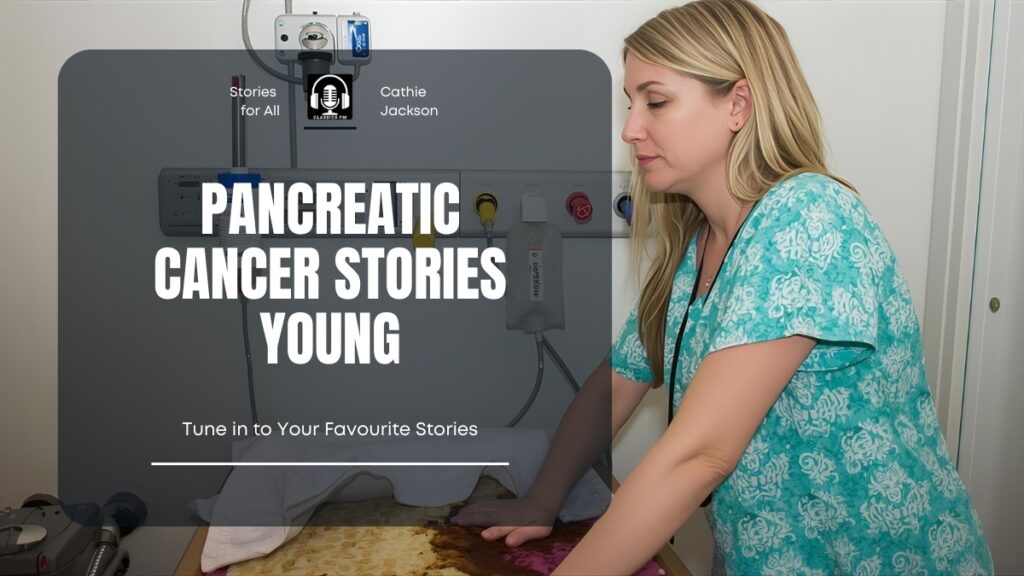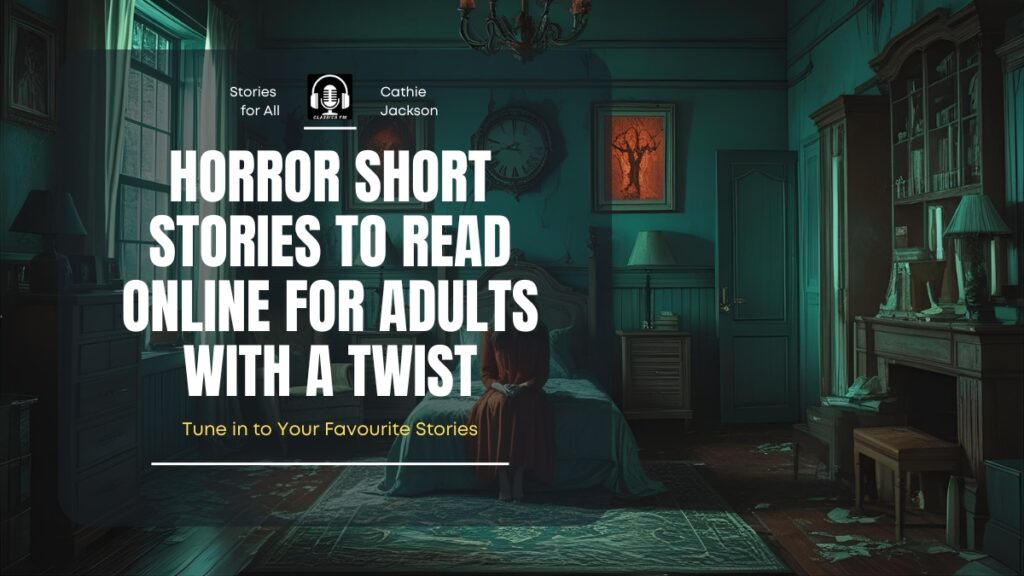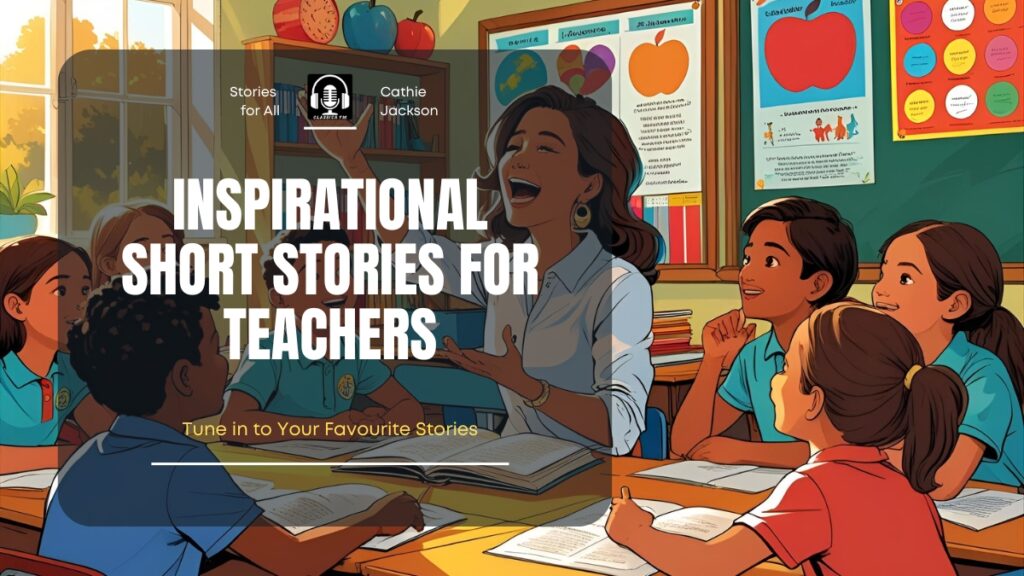Pancreatic Cancer Stories Young help people see that pancreatic cancer can affect young adults. Pancreatic Cancer Stories Young show real symptoms, real decisions, and real ways to get help.
If you are young and worried about pain, weight loss, or new diabetes, these stories can help you know what to do next.
Why read these stories?
Stories put medical facts into real life. They show how symptoms started, how doctors reacted, and how people handled treatment. Pancreatic Cancer Stories Young make it easier to know when to ask for tests. They also help families prepare for hard choices.
Quick facts in plain words
- Pancreatic cancer is serious. Early care helps.
- Most cases happen in older adults. Young adults can get it too.
- Genetics can raise the risk.
- Young people may need special help with work and family plans.
7 Pancreatic Cancer Stories Young
Pancreatic Cancer Stories Young remind us that this illness can touch lives far earlier than many expect. These stories are about strength, hope, and the courage to keep going even when life changes too soon.
1. Hannah’s Field Journal (Age 17, Wisconsin)
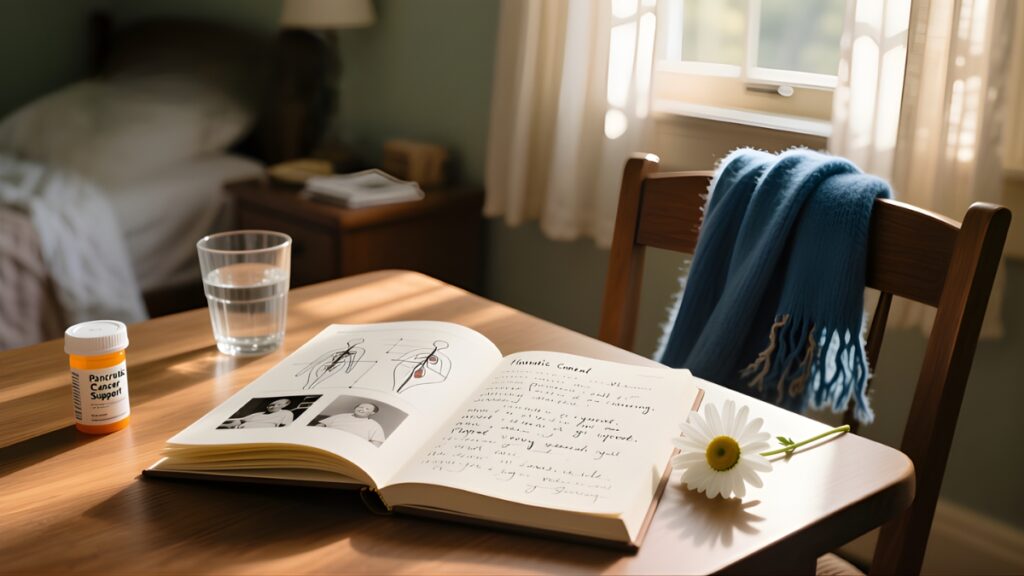
Hannah grew up in a quiet Wisconsin town.
The kind with long roads, open skies, and neighbors who waved from their mailboxes.
Her family’s house stood near a stretch of golden fields and a thin line of woods.
That’s where she spent most of her time — outside, notebook in hand, listening.
Birds filled her world.
Chickadees.
Cardinals.
Blue jays.
She knew them not only by sight but by song.
Her mother used to smile and say,
“If you ever get lost, we’ll just follow the birds. They’ll lead us right back to you.”
And somehow, everyone believed that.
The First Journal
When Hannah was six, her grandfather gave her a small brown notebook.
“Your field journal,” he called it.
“Write down anything worth remembering.”
At first, she wrote things like:
Saw a bird. It had wings. I think it liked me.
But as she grew, so did her words.
By seventeen, she had a shelf full of journals.
Each one carefully labeled.
Each one filled with sketches and notes about feathers, winds, and colors of dawn.
It wasn’t just observation.
It was love.
Quiet, patient love for the small things that make life beautiful.
When the Pain Began
The stomach pain started one spring afternoon.
At first, she brushed it off — exam stress, she thought.
But the ache deepened.
Doctor visits followed.
Then tests.
Then silence — the heavy kind before news that changes everything.
Hannah was seventeen when she was diagnosed with pancreatic cancer.
Her father cried quietly.
Her mother sat perfectly still, hand over her heart.
And Hannah, staring at her sleeve, thought only one thing:
I want to go outside.
The Hospital Days
Her small-town hospital was gentle and kind, but still — it wasn’t home.
Machines beeped softly at night.
The windows looked out over a parking lot instead of the fields she loved.
Her parents took turns sleeping in the chair beside her bed.
The nurses spoke in low, kind voices.
The doctors explained everything carefully.
But the world outside — the wind, the trees, the birds — felt far away.
And Hannah missed them deeply.
A Gift from a Teacher
One afternoon, her biology teacher, Mrs. Ellison, came to visit.
She brought a small green notebook with a pressed leaf on the cover.
“I thought you might want to keep observing,” she said softly, placing it on Hannah’s lap.
Hannah opened it.
The pages were blank.
Waiting.
She smiled.
And she began again.
What She Chose to Write
Hannah didn’t write about her illness.
She wrote about what she could still love:
The sound of rain on the window.
The nurse with a sunflower pin.
Her little brother’s jokes when he came to visit.
And, always — the birds.
Even from her hospital bed, she could hear them if she listened early enough in the morning.
Their faint songs drifted in through the glass.
The world, she realized, was still happening.
And she was still part of it.
Home Again
After several weeks of treatment, Hannah came home.
Winter had covered the fields in white.
But even in the cold, the birds stayed.
Cardinals flashed red against the snow.
Chickadees hopped along the fence posts.
Crows called from the bare trees.
Hannah sat wrapped in a blanket on the porch, her notebook in her lap, pencil steady in her hand.
She wrote:
“Today the wind is cold but kind.”
“The snow feels like quiet laughter.”
“The cardinal came back. He always does.”
Her mother watched from the window — tears in her eyes, but a small smile too.
Because even through pain, Hannah still saw beauty.
Returning to School
When her strength returned, Hannah went back to school for half days.
Her friends greeted her gently, unsure how to act.
But she smiled and said, “Hey,” as if everything was normal.
Her locker was decorated with paper birds.
Her desk in AP Biology — saved by her classmates — sat near the window.
Outside, she could see the fields.
It was enough.
For a while, that was enough.
Hard Days
There were days when she couldn’t get up.
Days when even breathing felt heavy.
Days when the world seemed far away.
On those days, her journal stayed closed.
Her mother would sit beside her, open an older notebook, and read aloud.
“Saw a robin with one feather missing. Still beautiful.”
“The wind smelled like honey today.”
“The world feels gentle right now.”
Those words, written in another time, helped heal things medicine couldn’t touch.
When Spring Came Back
The snow melted.
The fields turned green again.
And the birds returned — louder, brighter, alive.
Geese flew overhead.
Robins hopped through the yard.
Finches chattered in the bushes.
Hannah sat outside in her gray sweater, filling the last pages of her journal.
She wrote slowly now.
Not because she was weak —
But because she wanted to notice everything.
Every leaf.
Every sound.
Every breath.
The School Exhibit
At the end of the school year, Mrs. Ellison made an announcement during assembly.
The library lights dimmed.
She said, “We want to share something special.”
Behind her stood glass display cases — filled with pages from Hannah’s journals.
Tiny sketches.
Handwritten notes.
Little wonders about weather, light, and birdsong.
The sign above the exhibit read:
“Hannah’s Field Journal: A Celebration of Noticing.”
Students walked through silently.
Some cried.
Some smiled.
One whispered,
“It makes you realize how much we miss every day.”
And everyone nodded.
That Last Summer
By July, Hannah’s body had grown tired.
There were more hospital visits.
More naps.
More silence.
But her window stayed open.
Always open.
She listened to the summer air.
To the chirps and rustles.
To life, still moving around her.
One warm afternoon, she asked to go outside.
Her father carried her to the porch.
The sunlight touched her face.
A robin landed on the railing.
She smiled and whispered,
“I’m still here.”
Her mother rested her head on her shoulder.
Her little brother leaned against her.
And her father held her hand.
The world was still.
Completely still.
After Hannah
She passed peacefully that July — under a soft pink sky, the fields turning gold.
Her family buried one of her old journals under the oak tree where she first watched birds with her grandfather.
But they kept the green one — the hospital journal.
It now sits in her high school library, beside her photo.
Not as a memorial.
As a reminder.
A reminder to:
Breathe slowly.
Notice the small things.
Love what’s still here.
Her Legacy
Hannah didn’t teach people to be brave.
She taught them to be present.
To love the ordinary.
To see beauty before it disappears.
To live fully — even in stillness.
And in that way, she never really left.
Because every time someone steps outside and pauses,
Listening just a little longer to the sound of wings,
Hannah is there —
In the sunlight,
In the breeze,
In the quiet.
Still writing.
Still noticing.
Still here.
2. Cole’s Homecoming Night (Age 20, Texas)
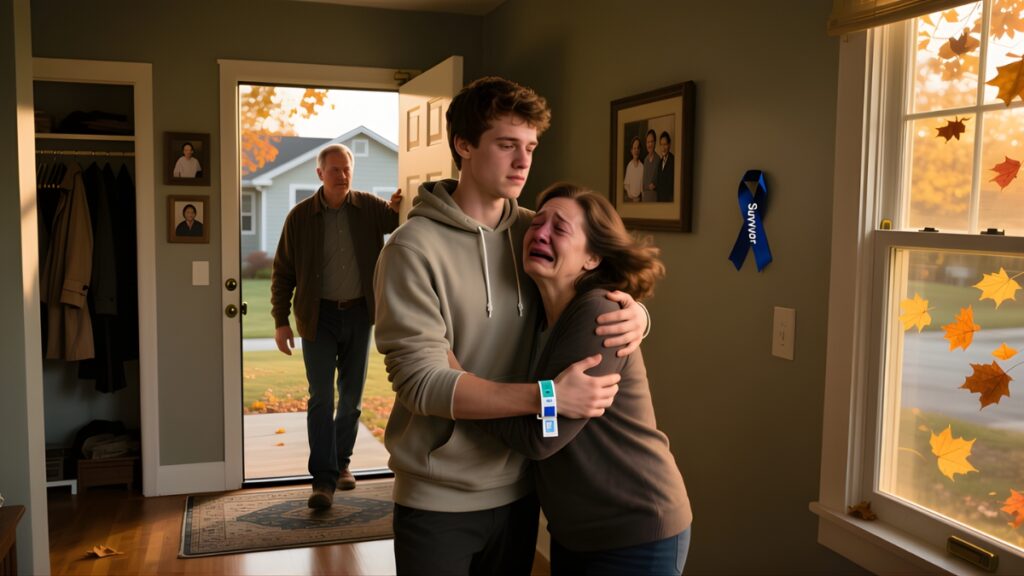
A Dream and a Trumpet
Cole Martinez was born and raised in a small Texas town where Friday nights meant football, and everyone in the bleachers knew your name.
He wasn’t a player, but he was still part of the field — trumpet in hand, heart in rhythm with the band.
He loved the sound of brass echoing under the stadium lights, the way the crowd cheered when the band marched in formation, and the laughter that followed every late-night practice.
Music was his world.
And engineering was his dream.
By the time he reached his sophomore year at Texas State University, he had a plan:
Finish his degree, get a job designing instruments, and make music part of science.
Everything was going just the way he imagined.
Until it wasn’t.
The Fatigue That Stayed
It started small — just tiredness.
Cole figured it was college life catching up with him. Long classes, late nights, too many energy drinks.
But the fatigue didn’t fade.
It deepened.
Soon, he couldn’t get through band practice without feeling dizzy.
Then came the pain — dull at first, then sharp.
His mother insisted he get checked.
After several tests and hospital visits, the doctors said words no 20-year-old expects to hear:
Pancreatic cancer.
His father squeezed his shoulder.
His mother cried softly into her hands.
Cole stared at the hospital floor and thought, “How can something this big fit inside one small word?”
Life on Pause
Treatment began quickly.
Chemotherapy. Scans. Long hours in a hospital room that smelled faintly of antiseptic and warm coffee.
His friends visited between classes, bringing stories from campus — dorm parties, marching band jokes, professors’ bad puns.
Cole laughed along, even when his body felt heavy.
He missed the music.
The noise.
The feeling of belonging to something loud and alive.
One day, when the band director called to check on him, Cole said quietly,
“I miss the sound of the field.”
And the director replied,
“Then we’ll bring the field to you.”
Studying from the Hospital
Cole refused to give up on school.
Between treatments, he attended online classes from his hospital bed, laptop propped on a tray table.
He worked on design projects with his classmates over video calls. Sometimes his voice was weak, but his ideas were strong.
When he couldn’t play the trumpet, he’d hum softly between IV drips, letting the tune fill the silence.
The nurses started recognizing his songs.
They’d hum along while changing his bandages or checking his vitals.
It became their quiet tradition —
A way of saying, “You’re still you.”
The Idea
By spring, Cole’s health had declined, but his spirit hadn’t.
Homecoming season was approaching.
He joked about sneaking onto the field with his IV pole and playing anyway.
His roommate, Tyler, thought for a moment — then texted the marching band group chat.
Within hours, an idea was born.
If Cole couldn’t come to homecoming,
Homecoming would come to him.
The Surprise
The hospital staff worked with the university to plan everything.
They kept it secret from Cole.
On a cool October afternoon, nurses wheeled him to the hospital courtyard for what they called “fresh air therapy.”
But when the doors opened, Cole froze.
The entire Texas State University Marching Band stood waiting.
Brass gleamed in the sunlight. Drums rested at the ready.
His parents stood beside the director, smiling through tears.
Tyler handed him his trumpet — polished, shining, ready to play.
Cole’s voice cracked,
“You’ve got to be kidding me.”
The director grinned.
“We never kid about music, son.”
And then the band began to play.
Homecoming in the Courtyard
It wasn’t a football field.
But it didn’t matter.
The sound filled the hospital courtyard — bold, proud, alive.
Cole stood slowly, holding the trumpet steady.
He lifted it to his lips and joined in for a few notes of his favorite song — “Sweet Caroline.”
Patients watched from their windows.
Nurses clapped from balconies.
Doctors paused in the hallways to listen.
When the song ended, Cole laughed through tears.
“Best halftime show ever,” he said.
And everyone cheered.
Five Slow Steps
When it came time for the band to leave, the director said,
“Cole, we’ve got one more thing for you.”
He gestured to a small red carpet laid across the courtyard floor.
“We’d like to present your honorary diploma early.”
Cole’s eyes widened.
He was supposed to graduate next year.
But the faculty had decided he’d earned it — not because of perfect grades, but because of perfect courage.
The crowd went silent.
Cole stood.
His father steadied him.
And he took five slow steps across that carpet.
Every step hurt.
Every step mattered.
When he reached the other side, everyone clapped — loud, bright, unrestrained.
Cole wiped his eyes and whispered,
“I made it.”
A Different Kind of Graduation
Later that evening, after the band packed up, the nurses brought cupcakes to his room.
His IV pole stood beside him like an old friend.
He scrolled through his phone, watching the video of the day over and over.
Hundreds of comments poured in from students and strangers alike:
“You showed us what real strength looks like.”
“I’ll never skip band practice again.”
“You made us proud, brother.”
Cole smiled.
He didn’t feel sick in that moment.
He felt part of something — bigger than music, bigger than illness.
He felt alive.
The Final Season
In the months that followed, Cole’s condition worsened.
Some days were long and silent.
Some were peaceful.
But he never stopped humming.
He said the quiet between songs was where courage lived.
His trumpet stayed beside his bed, gleaming softly under the hospital light.
He called it his “heartbeat instrument.”
One evening, he told Tyler,
“You know, I don’t think I’m scared anymore.
I think I just don’t want the music to stop.”
Tyler replied,
“It won’t. You started something that keeps playing.”
The Band That Never Stopped
Cole passed away one early spring morning, the same week the campus flowers began to bloom.
At his memorial, the marching band played “Sweet Caroline” once more.
No speeches. No long goodbyes.
Just music — bright and full of life.
His trumpet, polished to a mirror shine, rested on the podium surrounded by sunflowers — his mother’s choice.
The band director said quietly,
“He taught us that you don’t have to be loud to make a sound that lasts.”
A New Tradition
Every year since, during homecoming week, the band has marched one formation short — the “Cole Space.”
It’s an empty spot near the front line, where the sunlight hits first.
At halftime, the announcer says,
“And now, a moment of sound for Cole Martinez —
Who reminded us that even the quietest note can carry the loudest heart.”
Then the band plays “Sweet Caroline.”
And somewhere, in the echo of trumpets under the Texas sky,
You can almost hear him laughing.
What Cole Left Behind
Cole’s story became more than just a memory.
The university started a small scholarship for students balancing chronic illness with creative studies.
They called it the “Five Steps Forward” Award — in honor of the day Cole crossed that courtyard.
His friends visit the hospital every October, bringing cupcakes and music to other patients.
The nurses still remember him.
They say every time a student band comes to perform, they think of his smile.
Because Cole didn’t just leave behind a song.
He left behind an echo —
A promise that music, courage, and kindness can fill even the quietest halls.
Final Words
Cole once said,
“Graduation isn’t just about walking across a stage.
It’s about knowing you’ve lived something worth celebrating.”
And he did.
His story reminds us that even when life pauses,
Love doesn’t.
Music doesn’t.
Connection doesn’t.
Because sometimes, five slow steps
Are enough to take you all the way home.
3. Ava and the Rooftop Guitar (Age 15, New York City)

Ava Morales grew up in a brick apartment building in Queens, New York.
If you stood on the fire escape outside her bedroom window, you could see rows of buildings, laundry lines, taxi lights, and a slice of sky squeezed between rooftops.
It wasn’t quiet.
It was never quiet.
Sirens, buses, music from corner stores — the city felt like it was always awake.
And Ava loved that.
But what she loved most was her guitar.
A worn, honey-colored acoustic guitar her uncle gave her when she was eight.
She didn’t just play it.
She lived in it.
Her fingers moved like the city — fast, bright, full of feeling.
On evenings when the weather was warm, she climbed the stairs to the roof, sat next to the old metal railing, and played above the city lights.
Her mother said the guitar was Ava’s second heart.
Everyone who heard her play believed it.
When Things Changed
The first sign that something wasn’t right was the tiredness.
Ava thought it was just school pressure — exams, rehearsals, everything happening at once.
She brushed it off.
Then came the stomach pain.
Then weight loss.
Her parents took her to the doctor.
Then another doctor.
Then a specialist.
Finally, there it was — the word that quieted the whole room:
pancreatic cancer.
Her mother covered her mouth.
Her father squeezed her hand so tight she couldn’t feel her fingers.
Ava stared at the ceiling tile above her — a tiny crack shaped like a lightning bolt.
She didn’t cry.
She didn’t speak.
She just listened to the sound of her own heartbeat.
Thump. Thump. Thump.
Steady.
Soft.
Still hers.
Hospital Days and Rooftop Nights
Treatment began.
The hospital walls were white and smelled like bleach.
The windows showed buildings and sky, but the glass made everything feel far away.
Ava missed the rooftop.
She missed the open air.
The city noise.
The chocolate smell from the bakery across the street.
And most of all — she missed the feeling of music filling her body.
Her father brought her guitar to the hospital.
She couldn’t always play — sometimes her hands shook.
Sometimes she was too tired to lift it.
But she kept it with her.
Like a promise.
The Rooftop Problem
One day, after a long treatment session, Ava told her mother:
“I want to go home. I want to play on the roof.”
Her mother nodded.
They drove back to Queens.
But when Ava reached the apartment staircase, she froze.
Her legs felt weak.
Her breath felt thin.
The stairs to the rooftop seemed taller than skyscrapers.
She tried once.
Then again.
She sat down and cried for the first time since diagnosis.
Her father sat beside her on the stairwell step.
He didn’t say “It’s okay.”
He didn’t say “Be strong.”
He just wrapped his arm around her and said the only truth that mattered in that moment:
“You don’t have to do this alone.”
A Community That Listened
The next morning, Ava woke up to the sound of drilling.
She went to the hallway — confused.
Neighbors were gathered on the stairs.
Old Mr. Patel from the second floor.
The Rodriguez twins from downstairs.
Mrs. Greene, who always watered her plants at sunrise.
They were installing a chair lift along the stairway — a slow, steady, safe seat that could take Ava up to the rooftop.
Her mother stood beside them, teary-eyed.
“We all pitched in,” Mr. Patel said softly.
“As long as you want to play, we’ll get you there.”
Ava put her hand over her heart.
The city felt alive in her chest again.
The First Rooftop Return
Late that afternoon, she sat on the chair lift as it hummed upward.
Slow.
Steady.
Each floor passing like the pages of a book being turned.
When the rooftop door opened, the sky looked bigger than she remembered.
The breeze felt like a hug.
She sat by the metal railing.
Her father placed the guitar in her lap.
Her fingers moved slowly at first.
Then more surely.
Then with warmth.
The sound floated outward — above laundromat signs, across balcony plants, into street corners.
A few people opened windows to listen.
A child leaned out and waved.
Someone called out,
“Keep playing, sweetheart.”
She did.
Music for More Than Herself
The next week, her mother recorded a short clip of her playing a gentle tune — soft and calm, like rain on summer pavement.
She posted it on social media with the caption:
“Rooftop Medicine.”
The video spread.
Then spread again.
People commented from California, Texas, and overseas.
People who were sick.
People who were scared.
People who just needed something gentle in their day.
Ava replied to as many as she could:
“You’re not alone.”
“I’m rooting for you.”
“Hold on to something you love.”
Her music became a soft place for others to rest.
When Playing Became Harder
As months passed, treatment became heavier.
Her hands shook more often.
Her arms tired quickly.
Some days, she couldn’t play.
But she still went to the rooftop.
Still sat in her favorite spot.
On those days, she wound the little hand-crank music box her mother bought from a street vendor on 5th Avenue.
A tiny song.
Simple.
Sweet.
Barely louder than a whisper.
But it filled the roof just enough.
The Night That Everyone Came
One evening, neighbors gathered chairs and blankets around her.
Someone brought hot chocolate.
Someone brought fairy lights and strung them along the edges of the roof.
Someone brought a small speaker and microphone so Ava wouldn’t have to play loudly.
The rooftop turned into a tiny concert space — warm, glowing, held together by love.
Ava took a breath.
Her father squeezed her shoulder.
She began to play.
Slow.
Gentle.
Golden.
For fifteen minutes — the whole city felt quiet.
Her Words That Stayed
When asked how she stayed hopeful, Ava said:
“I don’t need to be strong every day.
I just need to not close my heart.”
And:
“I don’t want applause.
I just want company.”
Everyone listened.
And everyone stayed.
When Her Music Became Memory
Ava passed away on a clear spring morning.
The chair lift still sat on the stairway.
The rooftop still held her footprints.
Her guitar rested beside her bed.
The city did not go silent.
But it felt different.
Softer.
At her memorial, neighbors gathered on the rooftop once more.
They played the little music box.
They let the melody float into the sky she loved.
Someone whispered,
“Listen. The city remembers her.”
A Tradition in the Sky
Now, every year, on the anniversary of her rooftop concert, neighbors gather again.
Some bring guitars.
Some bring drums.
Some bring nothing but their hearts.
They sit under the open sky, above the traffic and the lights,
and they play.
Not loud.
Not perfect.
Just honest.
Because Ava taught them that music isn’t about volume — it’s about presence.
And that sometimes, the softest sound
is the one that stays the longest.
What Ava Left Behind
A chair lift that is now used by elderly neighbors.
A rooftop where people gather when they need comfort.
A playlist called “Rooftop Songs for Hard Days” that her father made.
A reminder that small music can heal big feelings.
Her mother keeps the music box on her bedside table.
She winds it once every morning.
Just once.
Just enough.
And every time the little chime plays,
she feels her daughter close —
bright, gentle, endless.
4. Jordan’s Last Lap (Age 18, Georgia)
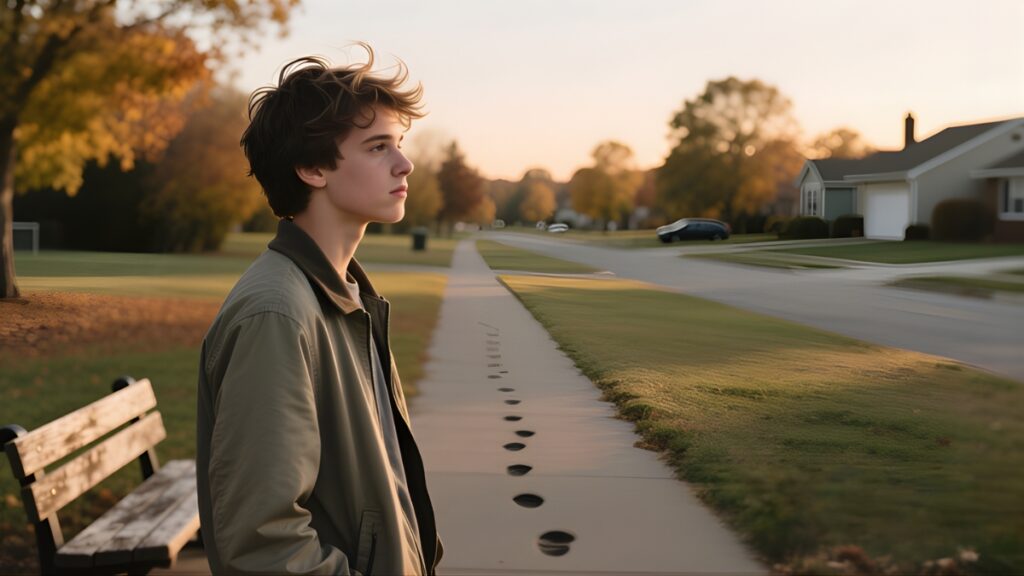
The Runner Everyone Knew
In the quiet town of Athens, Georgia, everyone knew Jordan Brooks.
He was the boy always running — down the track, across the neighborhood, through the park in early morning fog.
Running wasn’t just his sport. It was his language.
When teachers saw him at school, they’d say, “Jordan, slow down a little.”
He never did.
He had dreams bigger than the stadium lights — a scholarship, a college team, maybe even nationals one day.
His coach used to joke, “That boy doesn’t run. He flies.”
And everyone agreed.
The First Slow Step
It started one afternoon during practice.
Jordan was halfway through his laps when his vision blurred.
He slowed, stumbled, and sat down.
Coach Rivers ran over, water bottle in hand.
“You okay, J?”
Jordan nodded. “Yeah, just dizzy. Probably didn’t eat enough.”
He brushed it off. But the tiredness stayed.
Then came the pain — dull at first, then sharp under his ribs.
His mother took him to the hospital after he fainted in the kitchen one night.
The doctor’s face changed as the test results came in.
They called it pancreatic cancer.
Jordan blinked, confused.
“Isn’t that… an old person’s cancer?” he asked quietly.
The doctor’s silence was answer enough.
Learning to Breathe Again
The next few weeks were a blur of hospital visits, tests, and whispers behind doors.
His mother tried to stay strong.
His friends didn’t know what to say.
Coach Rivers visited with a track medal and said,
“We’ll keep a lane open for you. Anytime you’re ready to come back.”
Jordan smiled. “I’ll be back before you know it.”
But deep down, he wasn’t sure.
Running had always been how he faced the world.
Now even walking to the bathroom left him out of breath.
The Empty Track
One afternoon, after a long round of treatment, Jordan asked his mom to drive him by the high school track.
The sky was gold with sunset. The lanes glowed faintly red.
He sat in the bleachers, wrapped in a hoodie, watching his teammates run drills.
Each stride looked effortless, like flight.
He closed his eyes and imagined the sound of his own sneakers hitting the ground again.
Thud. Thud. Thud.
Fast. Steady. Free.
For a moment, he could almost feel the wind again.
Then his chest tightened.
His mother placed a hand on his shoulder.
“You okay?”
He nodded, even though tears had already begun to fall.
The Promise to Finish
That night, he told his mom,
“I just want one more race. My race.”
She didn’t ask how.
She just said,
“Then we’ll make it happen.”
And she did.
With Coach Rivers’ help, they planned a community 400-meter race — not for competition, but for love.
They called it “Jordan’s Last Lap.”
Training for One More Run
Jordan knew he couldn’t run like before.
His body was weaker.
His legs trembled.
But every day, he practiced walking to the end of the driveway, then back.
His father timed him, pretending it was training.
His little sister, Maya, drew a paper medal that said, “Champion Forever.”
When the pain got bad, he sat down.
But when he could, he stood again.
“I don’t care how slow I am,” he said.
“I just want to cross that line.”
Race Day
The whole town showed up.
Students. Teachers. Neighbors.
Even the mayor came.
They filled the bleachers with banners that read:
“Run with Jordan.”
“One Last Lap Together.”
The track glowed under the late afternoon sun.
Jordan stood at the starting line, trembling slightly, his sneakers bright against the lane.
Coach Rivers handed him a baton — gold tape wrapped around it.
“Take your time, kid. It’s your track.”
Jordan nodded.
He looked around at the faces — smiling, cheering, teary-eyed.
Then he looked up at the sky.
“Ready,” he whispered.
The Lap That Moved a Town
The gun fired softly — not for speed, but for spirit.
Jordan took his first step.
Then another.
The crowd went quiet.
Each stride was slow, deliberate, shaky — but steady.
His breath came hard, but he didn’t stop.
Halfway around, his knees wobbled.
Coach Rivers started toward him, but Jordan lifted a hand:
“I’ve got this.”
He kept going.
People began running alongside the track — teammates, classmates, his little sister waving her medal.
When he reached the final stretch, the crowd began to clap.
Softly at first.
Then louder.
Then thunderous.
Jordan crossed the finish line.
He raised the baton.
He smiled.
And he whispered,
“Told you I’d finish.”
The Afterglow
That night, the story spread everywhere — local papers, social media, radio stations.
But Jordan didn’t care about fame.
He cared about the people who ran beside him.
The laughter afterward.
The warmth of his family’s hug.
He told his mom before bed,
“It wasn’t my fastest race. But it was my best one.”
The Days After
Jordan’s health worsened in the following months.
He couldn’t train anymore, but he still went to the track on sunny days.
He’d sit on the bleachers, watch the younger runners, and smile when they looked his way.
Sometimes they’d ask for advice.
He’d always say the same thing:
“Run like you’re grateful you can.”
When he passed away that winter, the school held a candlelight vigil on the track.
Maya placed her paper medal in lane three — his favorite lane.
The wind that night was gentle, almost like breath.
A Legacy in Motion
The school renamed their annual spring meet “The Jordan Brooks Invitational.”
Each race begins with a moment of silence —
then the sound of one soft clap,
echoed by hundreds more.
The final event is always the 400-meter relay.
Every team passes a baton wrapped in gold tape.
Just like his.
Coach Rivers keeps Jordan’s shoes in his office.
On the wall, there’s a photo of that final race — Jordan crossing the line, smiling through exhaustion and sunlight.
Below it, a small plaque reads:
“Speed fades. Spirit doesn’t.”
The Family’s New Rhythm
Jordan’s mother, Denise, started a small foundation called The Last Lap Fund.
It helps young cancer patients stay connected to their sports, whether through adaptive gear, travel costs, or emotional support.
“Sports teach kids to keep moving,” she says.
“Even when life tries to stop them.”
Maya volunteers there every summer.
She tells everyone who visits,
“My brother didn’t lose. He finished differently.”
And somehow, that makes perfect sense.
The Lesson Jordan Left Behind
Jordan’s story isn’t just about illness.
It’s about motion.
About choosing to move even when life feels heavy.
He showed that victory isn’t measured in medals or records — it’s measured in moments when you keep going because your heart still wants to.
He taught everyone that slowing down isn’t failure.
Stopping isn’t giving up.
It’s just part of finding a new pace.
Remembering the Last Lap
Every year, on the anniversary of his race, runners from all over Georgia come to the same track.
They take one slow lap in silence.
No clocks.
No competition.
Just gratitude.
When they finish, they look toward the sky —
and someone always whispers what became his town’s quiet motto:
“Run like Jordan.”
5. Marisol’s Color Wall (Age 16, California)
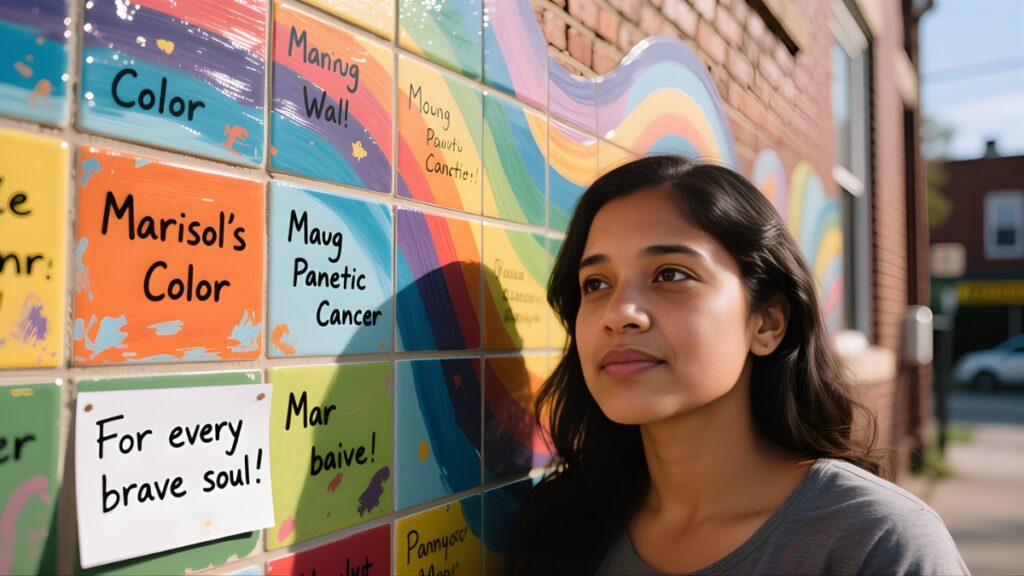
Marisol Rivera grew up in a small neighborhood outside San Diego, where the sun always seemed a little warmer and the air carried the faint smell of ocean salt and blooming jasmine.
She was known as the girl who painted.
Not the girl who was shy.
Not the girl who sat in the back of class.
Not the girl who didn’t talk much unless spoken to.
Just—
The girl who painted.
Her notebooks were full of sketches.
Her jeans always had smudges of color.
Her backpack jingled with tiny keychains she collected from art stores.
And everyone knew her favorite color: orange.
Not neon. Not sharp.
But warm orange.
The color of sunrise.
The color of hope.
The New Kind of Tired
At 16, Marisol had just started her junior year.
She was excited — new art classes, new projects, a new mural she wanted to paint for the school courtyard.
But then came the tiredness.
Not just the kind from staying up late on homework.
This tiredness sank deep.
Into her bones.
Into her breath.
Then came the stomach pain.
Then the nausea.
Then the weight loss.
Her mother took her to the doctor, thinking maybe it was nerves, or stress, or maybe anemia.
But the tests told a different story.
It was pancreatic cancer.
Stage III.
Fast.
Unexpected.
Unfair.
Marisol stared at the word on the page.
She felt the world tilt.
Not dramatically.
Just enough to change everything.
The Room That Changed With Her
The hospital room was white.
Too white.
Too clean.
Too empty.
It didn’t feel like her.
So her father brought her sketchbooks from home.
Her mother brought fairy lights.
Her little brother Mateo brought crayon drawings of the two of them holding hands.
But still — the room stayed quiet.
Still.
Cold.
Ungentle.
Marisol picked up a pencil.
Her hand shook.
But she steadied it.
She began to draw on small sticky notes.
Little sunsets.
Little flowers.
Little pieces of warm orange sunlight.
She stuck the first one above her bed.
Then another.
Then another.
Nurses started to notice.
They smiled.
“This room feels different,” one of them said.
“It feels alive.”
When Treatment Got Hard
Chemotherapy hit her harder than she thought it would.
Her thick brown curls fell onto her pillow.
Her arms bruised from needle after needle.
Her voice got softer.
Her laughter less frequent.
But her eyes — her eyes stayed full of color.
On the hardest days, when she could barely lift her hands, she whispered to her mother:
“Just hand me the pencil.”
Because drawing didn’t feel like work.
Drawing felt like breathing.
The Wall No One Expected
One morning, while walking down the hallway for tests, she paused.
There was a long blank wall by the cafeteria.
Plain.
Colorless.
Forgotten.
She stood there, staring.
A nurse noticed her and asked,
“What are you looking at, Marisol?”
Marisol answered:
“I want to paint this wall.”
The nurse blinked.
Then smiled.
“Let me ask.”
The hospital board discussed it.
Some hesitated —
“Is it safe?”
“Is it allowed?”
But others understood what art could do.
So they said yes.
But only if Marisol had help.
Her art teacher came.
Her classmates came.
Neighbors came.
Her father built scaffolding.
Her best friend Ana brought music to play in the background.
And then —
Marisol began.
The First Stroke
She lifted a brush dipped in warm orange paint.
Her hand trembled.
But she took a breath.
She pressed the brush to the wall.
Slow.
Gentle.
Steady.
That first stroke felt like coming home.
Then came yellow.
Then pink.
Then soft blues and greens.
The mural wasn’t a single picture.
It was a sunrise stretching across the wall —
full of shapes like waves, flowers, birds, and hands reaching toward the light.
People walking by stopped and stared.
Some cried.
Some smiled.
Some touched the wall softly, like it might warm their palms.
What the Wall Became
The mural turned into something more than art.
It became a place people met.
A place where tired families rested.
A place where patients sat quietly, breathing in color instead of fear.
Children recovering from surgeries sat underneath it with crayons.
Teenagers whispered stories to each other in front of it.
Doctors leaned on the wall between long shifts.
One afternoon, an elderly man in a wheelchair said to Marisol,
“This wall makes the world feel less heavy.”
Marisol smiled.
“That’s what I was hoping for.”
When the Pain Returned
Months passed.
Her cancer grew.
Her treatments became harder, longer, heavier.
Her body fought for every breath.
There were days she couldn’t make it to the wall.
Days when her bed became her world.
But her friends continued the mural with her sketches.
They would bring progress photos to her bedside.
She would nod weakly and whisper,
“More orange. Always more orange.”
The Night the Wall Was Finished
The mural was completed on a warm Spring evening.
The lights in the hallway dimmed.
The wall glowed in soft gold tones.
Her family wheeled her to see it one last time.
She was wrapped in a blanket.
Her head resting on her mother’s shoulder.
Everyone gathered quietly.
Doctors. Nurses. Friends.
Not to say goodbye.
But to witness.
Marisol reached out with her trembling hand and pressed her palm gently to the wall.
She whispered,
“Thank you for letting me stay a little longer.”
Her mother began to cry.
Marisol didn’t cry.
She just looked at her sunrise.
Her warmth made visible.
Her heart left behind.
The Day She Let Go
A week later, Marisol passed away.
Peacefully.
Softly.
In the middle of a golden morning.
Her family was with her.
Her favorite color sunrise spread across the sky.
The Wall Lives On
Today, the hospital calls it Marisol’s Color Wall.
People still gather there.
To rest.
To hope.
To breathe.
School art classes visit every spring.
Children place paper flowers at the base.
Patients trace the soft swirls of sunrise with their fingertips.
There is a small plaque beside it that reads:
“To every person facing darkness — may you remember that the sun still rises.”
— Marisol Rivera, Age 16
Her Family’s Promise
Her parents started a small foundation that provides free art supplies to young cancer patients.
They send boxes filled with watercolor palettes, sketch pads, markers, and tiny notes that say:
“Color is a kind of courage.”
Every box carries Marisol’s spirit.
What She Left Us
Marisol did not get the chance to grow old.
She did not get to paint every mural she dreamed of.
But she left something powerful.
She showed that hope does not have to be loud.
It can be gentle.
Soft.
Quiet.
Hope can look like warm orange paint on a blank wall.
Hope can look like someone saying,
“I know this is hard, but we can still make something beautiful.”
And because of her, thousands of people have felt that warmth.
Every day.
Every year.
Ongoing.
6. Wyatt and the Wristband Promise (Age 22, Kansas)
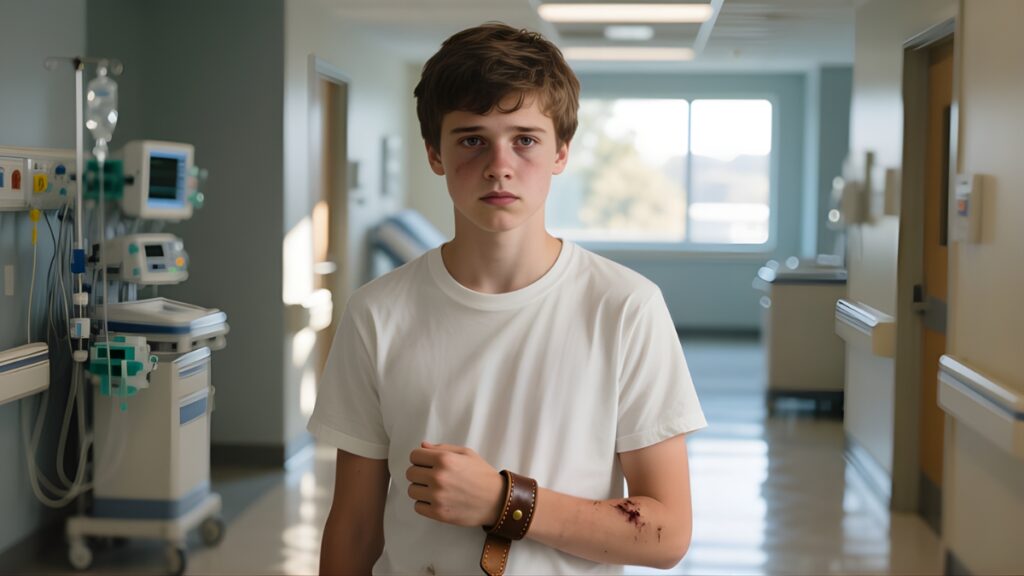
In the small town of Lawrence, Kansas, everyone knew Wyatt Miller.
He wasn’t the loudest in the room, but somehow he was the one people noticed most — because he noticed them.
If someone’s car broke down, Wyatt was there with jumper cables.
If a classmate was crying after a breakup, he showed up with milkshakes and silence.
He was the guy who didn’t need to fix everything; he just stayed.
At 22, Wyatt had just graduated from the University of Kansas with a degree in graphic design.
He worked part-time at a local print shop and spent weekends helping his dad renovate their old farmhouse.
He was healthy, strong, and always moving.
Until the day he wasn’t.
The Pain That Wouldn’t Leave
It started with what he thought was food poisoning.
Stomach cramps. Fatigue.
Then, a dull ache that kept him up at night.
He brushed it off.
“I’m fine, Mom,” he’d said over the phone. “Probably just junk food and too much coffee.”
But the pain grew worse.
One night, after throwing up blood, his roommate took him to the ER.
Tests. Scans. Waiting.
Then came the doctor’s face — kind, but serious.
It was pancreatic cancer.
Stage IV.
Fast-moving.
Aggressive.
Wyatt stared at the floor, unable to speak.
He was 22.
This couldn’t be real.
The World Tilted
His parents drove four hours to the hospital.
His mother cried quietly in the waiting room.
His father just held his hand.
Friends came by, unsure what to do.
Some brought balloons.
Some sat in silence.
Some didn’t come at all — too scared, too heartbroken, too unsure how to face him like this.
Wyatt understood.
He said softly,
“People don’t mean to disappear. They just don’t know how to stay.”
That night, he lay awake thinking about that.
He didn’t want people to run away from hard things — not his friends, not anyone.
The Idea
A few days later, his nurse noticed him sketching something on a napkin.
She asked what it was.
Wyatt smiled weakly.
“A reminder. For my friends. For anyone who feels helpless.”
It was a simple design — a thin wristband with three words etched across it:
“Just Stay Here.”
He explained,
“People always try to say the right thing when someone’s hurting.
But sometimes, there are no right words.
You just have to stay.”
The First Batch
With help from his old print shop, he ordered 100 silicone wristbands.
Bright blue — his favorite color.
He handed them out to his friends, nurses, even strangers who visited his room.
Each time he gave one away, he said the same thing:
“You don’t have to fix it. You don’t have to understand it.
Just stay beside the people who hurt. That’s enough.”
Soon, pictures of the wristbands started appearing online.
College friends posted them with captions like:
“Staying for Wyatt.”
“You don’t need the right words — just love.”
The simple message spread faster than anyone expected.
The Hospital Family
Wyatt became known as the wristband guy at the hospital.
He started talking with other young patients — kids, teens, adults his age — anyone who felt alone.
He listened more than he spoke.
He made people laugh when they forgot how.
He designed new wristbands with colors that matched their stories.
A purple one for a teenage girl who missed her prom.
A green one for a dad who couldn’t attend his son’s soccer games.
A yellow one for a nurse who had just lost her own mother.
Each band carried a quiet promise:
“You’re not alone.”
The Hard Months
As the months passed, his treatments grew tougher.
The nausea, the weakness, the endless tests.
But even on the hardest days, when he could barely move, he kept designing.
His laptop sat on a small table beside his hospital bed.
He used it to create new layouts, test fonts, mix colors.
His mom often whispered,
“You should rest.”
Wyatt would grin and reply,
“I am resting. Just with purpose.”
The Viral Moment
One morning, a nurse posted a photo of her blue wristband with the caption:
“This came from a 22-year-old who teaches us what real love looks like.”
Within hours, the post spread across social media.
People began ordering wristbands from all over the country.
College groups. Church communities. Cancer support centers.
Even firefighters in another state wore them to show solidarity.
Wyatt was stunned.
He said,
“I didn’t mean to start something big.
I just didn’t want anyone to feel alone.”
But big it became.
The Last Promise
In his final months, Wyatt’s condition worsened.
The cancer had spread.
Pain became constant.
He asked his best friend, Alex, to take over the wristband project.
They sat together late one night, surrounded by boxes of bands ready to ship.
Alex said, “I don’t know if I can do this without you.”
Wyatt smiled faintly.
“You won’t be without me. I’ll still be here — every time you hand one out.”
He tapped his wrist.
“That’s the promise.”
The Quiet Goodbye
Wyatt passed away on a cool spring morning, sunlight streaming through the hospital blinds.
His parents were there.
His friends were there.
His wristbands — stacked in bright blue boxes — lined the window sill.
The hospital staff wore them that day.
So did his entire college class.
No speeches.
No long goodbyes.
Just presence.
Just staying — exactly as he’d wanted.
The Ripple That Followed
After his passing, his friends officially launched The Wyatt Promise Project.
Their mission: to spread compassion and emotional presence to young people facing illness, loss, or loneliness.
They shipped wristbands to schools, hospitals, and mental health centers across the U.S.
Each package included a note written in Wyatt’s handwriting:
“When you don’t know what to say, don’t walk away.
Just stay.”
The project partnered with several universities to host Stay Here Weeks, where students learned about supporting peers through mental health struggles.
And every October, Wyatt’s birthday, they host an event called Blue Band Day, encouraging people everywhere to wear a blue wristband and reach out to someone who might need company.
The Family’s New Mission
Wyatt’s parents, Mark and Linda, now travel to share his story.
They talk to high schoolers about kindness that lasts — kindness that doesn’t need words.
Mark always ends his talks the same way:
He holds up his wrist, showing the faded blue band he’s worn since the day Wyatt gave it to him.
And he says softly,
“It’s not just plastic. It’s a promise.”
Alex’s Reflection
Alex, now running the project full-time, keeps Wyatt’s laptop on his desk.
The wallpaper still reads, “Stay with them.”
Every time a new message comes in — someone saying the wristband helped them through depression, grief, or illness — Alex feels that same quiet warmth.
He often says,
“Wyatt built something that doesn’t end.
Because the world always needs someone who stays.”
The Lesson Kansas Keeps
In Lawrence, there’s a mural downtown — painted by local artists and Wyatt’s old classmates.
It shows a hand holding another, with bright blue bands around both wrists.
Above it, simple white letters read:
“You Don’t Need the Right Words — Just Stay.”
People often leave flowers beneath it.
Sometimes letters.
Sometimes their own wristbands.
The message is clear, quiet, and lasting —
just like Wyatt.
The Legacy of Presence
Wyatt’s story reminds us that not all heroes are fighters in stadiums or soldiers in war.
Some are the ones who sit beside us when life breaks apart — and don’t leave.
He taught that love is not found in perfect speeches or grand gestures.
It’s found in staying —
in silence,
in kindness,
in the small courage of being there.
Every wristband handed out continues that message.
Every person wearing one carries a piece of Wyatt’s heart.
And that, truly, is how he still stays.
7. Grace and the Sun Porch (Age 14, North Carolina)
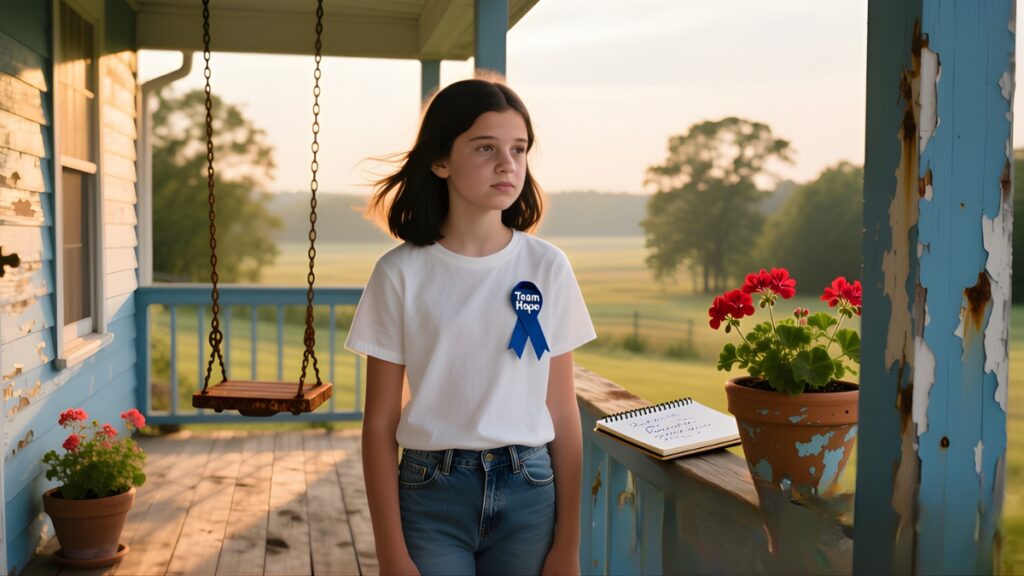
Grace Benton was the kind of girl who noticed the small things.
The curl of a leaf after rain.
The hum of bees near the porch steps.
The way light shifted across her mother’s garden through the day.
Her favorite place in the world was the old sun porch at the back of their house in Asheville, North Carolina.
It wasn’t fancy — just a creaky wooden floor, wicker chairs, and windows that opened wide to the sound of crickets.
But to Grace, it was magic.
That was where she read, painted, and dreamed about her future — art school, a studio by the ocean, and maybe even a gallery someday.
At fourteen, she had no reason to believe her life would be anything other than bright and open, like the porch she loved so much.
Until the day she got sick.
The Ache That Wouldn’t Go Away
It began as stomach pain.
Then came the nausea, the fatigue, the weight loss.
Her mother thought it was stress.
Her father thought it was a growth spurt.
But Grace knew something was wrong.
After weeks of hospital visits, scans, and whispered conversations outside her room, the doctor came in with quiet eyes.
He said words Grace didn’t fully understand —
pancreatic tumor, malignant, rare in children.
Her parents cried.
Grace didn’t.
She stared at her hands, small and pale under the fluorescent light, and whispered,
“I don’t want to leave my porch.”
The House That Grew Silent
The following months turned the Benton home into a quiet storm.
Her mother, Anna, quit her job to care for her.
Her father started working from home, pretending he wasn’t falling apart.
Grace’s paints gathered dust in the corner.
The brushes stiffened.
The porch — once full of sunlight and laughter — grew silent.
Even the wind seemed to hesitate when it passed through.
One evening, Grace asked her mom,
“Do you think the porch misses me?”
Her mom tried to smile, but tears filled her eyes.
“I think it’s waiting for you.”
A New Kind of Canvas
Chemotherapy hit Grace hard.
She lost her hair, her appetite, and her strength.
But she didn’t lose her eyes — those curious, gentle eyes that still noticed light and color even in a sterile hospital room.
Her art teacher, Mrs. Larson, visited one afternoon with a small watercolor set and sketchbook.
“Your hands still work,” she said softly.
“So let them.”
Grace began painting again — not big, detailed pieces like before, but tiny sketches.
A window view.
Her mom’s hand holding hers.
The nurse’s smile.
A cup of tea steaming on the bedside tray.
Every picture was signed the same way, in looping cursive:
“For the porch.”
The Porch Revival
When Grace was well enough to return home for a short break, her parents had a surprise waiting.
The porch had been transformed.
Her father had repaired the windows.
Her mother had scrubbed and painted the floorboards a soft sunflower yellow.
But the best part — covering the back wall — were dozens of frames, each holding one of Grace’s hospital paintings.
Grace gasped.
She touched one of the frames gently and whispered,
“It’s like the porch came to see me.”
Her mother hugged her tightly.
“Now it’s your gallery, sweetheart.”
Grace spent hours sitting there that week, sketching more than ever.
She said the porch made her feel strong again, like sunlight could heal her from the inside.
The Online Gallery
One of Grace’s friends, Amelia, helped her start a small online page to share her art.
They called it “The Sun Porch Project.”
Grace uploaded every watercolor — bright, small moments of beauty from a hospital world.
Each piece carried a short caption, usually a few hopeful words:
“Light still finds its way.”
“There’s beauty in slow days.”
“This one’s for anyone who misses home.”
Within weeks, messages began to pour in.
From patients.
From nurses.
From strangers across the country.
People said her art made them feel peace again.
Some sent their own pictures of porches, windows, and gardens — little pieces of light, shared back.
Grace read every message.
She said,
“It’s like my porch grew wings.”
The Hardest Season
Winter came early that year.
Grace’s treatments stopped working.
Her body weakened, but her spirit never dimmed.
Her parents moved a hospital bed into the sun porch so she could be surrounded by her favorite light.
Even on cold mornings, she asked for the windows to stay open.
She said she wanted to hear the birds.
When she was too tired to paint, she asked her mom to read the comments people sent on her art page.
One day, she whispered,
“Do you think I helped anyone?”
Her mom kissed her forehead.
“You helped the world, Grace.”
The Last Painting
A few days before she passed, Grace asked for her paints one last time.
Her hands trembled, but her strokes were sure.
The painting showed a simple porch bathed in sunlight.
Two chairs.
A table.
An open door.
On the back, she wrote:
“There’s always light waiting somewhere. Find it.”
Her mother framed that painting the next morning.
It hung above Grace’s bed until the end.
The Town That Remembered
After her passing, word about Grace’s art spread across North Carolina.
Local news covered her story.
Her high school organized a small exhibit called “Light Still Finds Its Way.”
Visitors cried, smiled, and bought prints.
The proceeds went to fund art supplies for children in cancer wards.
The Bentons also opened their porch every spring for a small community art day.
Kids from the neighborhood would come to paint, laugh, and leave their drawings pinned along the railings.
The porch that once waited in silence now sang with color.
The Global Porch
A few years later, Grace’s online page had grown beyond anything her family imagined.
Thousands of people shared art inspired by her.
From Brazil to Japan, young artists painted their own “sun porch” scenes and used the tag #LightFindsItsWay.
Hospitals began setting up “Sun Porch Corners” — small art spaces for young patients to paint, write, and feel sunlight through windows.
Every wall carried a small plaque that read:
In memory of Grace Benton — who showed us how to find light, even in shadows.
Her Mother’s Reflection
Anna Benton still sits on the porch every morning with her tea.
Sometimes she feels the soft brush of sunlight and whispers,
“Good morning, Gracie.”
The yellow floorboards shine beneath her.
The walls are filled with framed art — not just Grace’s, but hundreds of paintings mailed from children all over the world.
Some are messy.
Some are beautiful.
All of them carry warmth.
Anna says,
“When you lose someone, the world feels dim.
But Grace left enough light for all of us.”
The Legacy of Light
Grace’s story isn’t one of sadness alone.
It’s about the way love lingers in color, in laughter, in the soft light of ordinary places.
Her porch became a symbol — of home, hope, and quiet bravery.
Every child who paints in a hospital somewhere keeps her story alive.
Every brushstroke whispers her words:
“There’s always light waiting somewhere. Find it.”
Clear symptoms people report
In many Pancreatic Cancer Stories Young, people describe similar signs. If you notice any of these, see a doctor.
- Losing weight without trying.
- Pain in the upper belly or pain that goes to the back.
- Yellow skin or yellow eyes.
- New diabetes or sudden high blood sugar.
- Strange blood clots or long lasting tiredness.
Write down when each symptom started. That record helps doctors act faster.
Why diagnosis can be slow
Young people often get told their symptoms are stress or a stomach problem. Doctors may treat common issues first. Many Pancreatic Cancer Stories Young include a delay in getting imaging tests. If you have a steady problem, ask for an imaging test.
How diagnosis usually works
Most stories follow this path:
- Visit the primary care doctor with a clear symptom list.
- Blood tests and possibly an ultrasound.
- CT scan or MRI for clearer pictures.
- Endoscopic ultrasound for detailed views and biopsy.
- Lab tests on the biopsy.
- Gene testing on the tumor for targeted treatment.
If symptoms do not stop, ask your doctor for the next step in testing.
Genes and family history in simple terms
Some Pancreatic Cancer Stories Young show a genetic link. Genes like BRCA and PALB2 may raise risk. If a young person has cancer, doctors often suggest genetic testing. If a gene change is found, family members may also get tested or monitored.
Treatments described in the stories
Treatment depends on how far the cancer has spread. Common options include:
- Surgery to remove the tumor if it is possible.
- Chemotherapy to slow or stop cancer growth.
- Targeted drugs when a specific gene change is found.
- Clinical trials for new medicines or methods.
Younger people sometimes handle strong treatments better. Each plan is personal.
Why clinical trials matter
Many Pancreatic Cancer Stories Young mention clinical trials. Trials can offer new medicines. They may extend life or improve quality of life. Trials often require travel. Ask your care team about trial options.
Everyday concerns in the stories
Young people tell about many practical problems. Common worries include:
- Fertility. People ask whether treatment will affect future children.
- Work and money. Treatment can mean time off work or new expenses.
- Child care. Parents worry about how to care for kids during treatment.
- Mental health. Stress and fear are common and deserve support.
Talk to a social worker, a fertility specialist, and a counselor early.
Short real-life examples (anonymous)
Case 1: A 34-year-old had steady back pain and lost weight. Early tests showed nothing. After more scans a tumor was found. Surgery and chemo followed. The person later joined a trial.
Case 2: A 42-year-old suddenly developed diabetes and lost weight. A scan found a tumor. Gene testing found a mutation that guided treatment. Family members were then offered testing.
Case 3: A 29-year-old had pain like gallbladder pain. Surgery for gallstones did not stop the pain. Further scans showed a tumor. The person urges others to push for follow up when pain continues.
How to use these stories the right way
Stories should guide action. They are not a way to self diagnose. Use a story to prepare questions for your doctor. Take your symptom notes and family history to the visit. Ask for imaging when symptoms last or get worse.
Doctor visit checklist
Bring these items to your appointment:
- A clear timeline of each symptom with dates.
- Family history of cancer, with ages if known.
- A list of medicines and recent tests.
- Your top three questions for the doctor.
- A request for imaging if symptoms persist.
- A question about genetic testing if you are young or your family has cancer.
Write the checklist before the visit to make the visit focused.
Words to use with your doctor
You can say things that make the problem clear. Try these short lines:
- “This pain started X weeks ago and it is worse now.”
- “I lost X kilograms without trying.”
- “I have new diabetes with no family history.”
- “My eyes or skin look yellow.”
Clear words help doctors choose the right tests.
Fertility, pregnancy, and family planning
If treatment might affect fertility, ask about sperm or egg freezing before treatment starts. If you are pregnant, tell your team. Treatment choices may change with pregnancy in mind.
Money and work help
Many people in Pancreatic Cancer Stories Young share money worries. Hospitals often have social workers and financial counselors. Ask about medical leave and local supports early. That help can reduce stress.
Food and strength during treatment
Good nutrition helps during treatment. Practical tips from stories:
- Eat small meals often.
- Choose foods with protein and calories.
- Use meal delivery or help from friends.
- Talk to a dietitian for a plan that fits your side effects.
Small steps add energy and help healing.
Practical tips from stories
- Keep a symptom diary with dates and notes.
- Ask for copies of imaging and reports for second opinions.
- Plan ahead for fertility if you want children.
- Use telehealth when travel is hard.
- Find a reliable friend or family member who can help with calls and chores.
The most common myths, made simple
Myth: Pancreatic cancer only affects older adults.
Fact: Pancreatic Cancer Stories Young show that young adults can get it.
Myth: Nothing can be done.
Fact: Early testing, targeted treatment, and trials can help many people.
Quick voice search answers
Q: What are early signs of pancreatic cancer in young adults?
A: Weight loss, steady belly or back pain, yellow skin, new diabetes, and fatigue.
Q: Should a young adult get imaging for persistent belly pain?
A: Yes. If pain lasts or comes with weight loss or yellowing, ask your doctor for imaging.
How caregivers can help, in practical terms
Caregivers make daily life easier. They can:
- Drive to appointments and take notes.
- Help with meal prep and house tasks.
- Manage calls with insurance and doctors.
- Watch for new symptoms and tell the care team.
Small acts of help make a big difference.
Explaining things to children
Keep answers short and honest. Use words they understand. Keep routines like bedtime and meals when possible. Let children ask questions and answer them simply.
Papers and records to keep clear
Keep these documents in a folder:
- Imaging and pathology reports with dates.
- Contact information for the main doctors.
- A note of medicines and side effects.
- Any legal papers like healthcare power of attorney.
Share copies with your care team and one trusted family member.
Preparing for each visit
Before a visit, do these five things:
- Update your symptom diary with dates.
- Write three key questions to ask.
- Bring a person who can take notes.
- Ask the doctor to summarize the visit in the patient portal.
- Get copies of any tests or reports done that day.
These steps make care clearer and faster.
Keeping good records for second opinions
Ask for copies of scans and reports. A second team can review them faster when records are clear. This is a common step in many Pancreatic Cancer Stories Young.
Small self-care steps that help
- Rest when you feel tired.
- Accept help from friends and family.
- Keep simple meals ready.
- Talk to a counselor if you feel overwhelmed.
- Celebrate small improvements.
FAQs for people who search with long questions
Q: Can young people survive pancreatic cancer?
A: Yes. Outcomes depend on stage at diagnosis and access to care. Early detection helps.
Q: Should I ask for genetic testing?
A: If you are young at diagnosis or have a family history of cancer, ask about genetic testing.
Q: What should I do if my doctor says my symptoms are not serious?
A: If symptoms continue or get worse, ask for imaging or a specialist referral.
Final simple steps to take now
- Write down your symptoms with dates.
- Make an appointment and bring your list.
- Ask for imaging if symptoms do not improve.
- Ask about genetic testing if you are young or have family history.
- Reach out for help with work and daily tasks.
Conclusion
Pancreatic Cancer Stories Young show that pancreatic cancer can affect young people. Pancreatic Cancer Stories Young help families notice symptoms and get help sooner.
If a story sounds like your life, record your symptoms, see your doctor, and ask for the right tests. Your notes and your questions help the care team act fast. Share your story if you wish. Your experience can help others.

